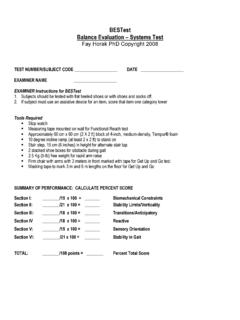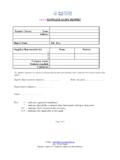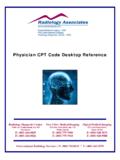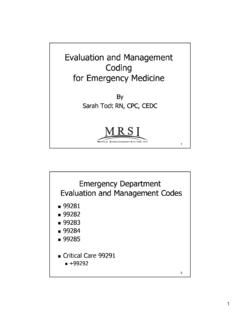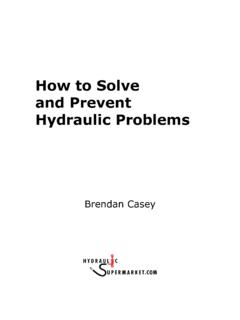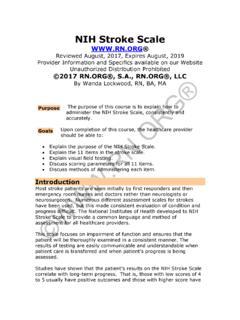Transcription of Mini-BESTest: Balance Evaluation Systems Test © …
1 mini - bestest : Balance Evaluation Systems Test 2005-2013 Oregon Health & Science University. All rights reserved. _____ 1. SIT TO STAND Instruction: Cross your arms across your chest. Try not to use your hands unless you must. Do not let your legs lean against the back of the chair when you stand. Please stand up now. (2) Normal: Comes to stand without use of hands and stabilizes independently. (1) Moderate: Comes to stand WITH use of hands on first attempt. (0) Severe: Unable to stand up from chair without assistance, OR needs several attempts with use of hands. 2. RISE TO TOES Instruction: Place your feet shoulder width apart. Place your hands on your hips.
2 Try to rise as high as you can onto your toes. I will count out loud to 3 seconds. Try to hold this pose for at least 3 seconds. Look straight ahead. Rise now. (2) Normal: Stable for 3 s with maximum height. (1) Moderate: Heels up, but not full range (smaller than when holding hands), OR noticeable instability for 3 s. (0) Severe: < 3 s. 3. STAND ON ONE LEG Instruction: Look straight ahead. Keep your hands on your hips. Lift your leg off of the ground behind you without touching or resting your raised leg upon your other standing leg. Stay standing on one leg as long as you can. Look straight ahead. Lift now. Left: Time in Seconds Trial 1:_____Trial 2:_____ (2) Normal: 20 s.
3 (1) Moderate: < 20 s. (0) Severe: Unable. Right: Time in Seconds Trial 1:_____Trial 2:_____ (2) Normal: 20 s. (1) Moderate: < 20 s. (0) Severe: Unable To score each side separately use the trial with the longest time. To calculate the sub-score and total score use the side [left or right] with the lowest numerical score [ the worse side]. _____ 4. COMPENSATORY STEPPING CORRECTION- FORWARD Instruction: Stand with your feet shoulder width apart, arms at your sides. Lean forward against my hands beyond your forward limits. When I let go, do whatever is necessary, including taking a step, to avoid a fall. (2) Normal: Recovers independently with a single, large step (second realignment step is allowed).
4 (1) Moderate: More than one step used to recover equilibrium. (0) Severe: No step, OR would fall if not caught, OR falls spontaneously. 5. COMPENSATORY STEPPING CORRECTION- BACKWARD Instruction: Stand with your feet shoulder width apart, arms at your sides. Lean backward against my hands beyond your backward limits. When I let go, do whatever is necessary, including taking a step, to avoid a fall. (2) Normal: Recovers independently with a single, large step. (1) Moderate: More than one step used to recover equilibrium. (0) Severe: No step, OR would fall if not caught, OR falls spontaneously. 6. COMPENSATORY STEPPING CORRECTION- LATERAL Instruction: Stand with your feet together, arms down at your sides.
5 Lean into my hand beyond your sideways limit. When I let go, do whatever is necessary, including taking a step, to avoid a fall. Left (2) Normal: Recovers independently with 1 step (crossover or lateral OK). (1) Moderate: Several steps to recover equilibrium. (0) Severe: Falls, or cannot step. Right (2) Normal: Recovers independently with 1 step (crossover or lateral OK). (1) Moderate: Several steps to recover equilibrium. (0) Severe: Falls, or cannot step. Use the side with the lowest score to calculate sub-score and total score. _____ 7. STANCE (FEET TOGETHER); EYES OPEN, FIRM SURFACE Instruction: Place your hands on your hips. Place your feet together until almost touching.
6 Look straight ahead. Be as stable and still as possible, until I say stop. Time in seconds:_____ (2) Normal: 30 s. (1) Moderate: < 30 s. (0) Severe: Unable. REACTIVE POSTURAL CONTROL ANTICIPATORY SENSORY ORIENTATION / 6 SUB SCORE: / 6 SUB SCORE: / 6 SUB SCORE: 8. STANCE (FEET TOGETHER); EYES CLOSED, FOAM SURFACE Instruction: Step onto the foam. Place your hands on your hips. Place your feet together until almost touching. Be as stable and still as possible, until I say stop. I will start timing when you close your eyes. Time in seconds:_____ (2) Normal: 30 s. (1) Moderate: < 30 s. (0) Severe: Unable. 9. INCLINE- EYES CLOSED Instruction: Step onto the incline ramp.
7 Please stand on the incline ramp with your toes toward the top. Place your feet shoulder width apart and have your arms down at your sides. I will start timing when you close your eyes. Time in seconds:_____ (2) Normal: Stands independently 30 s and aligns with gravity. (1) Moderate: Stands independently <30 s OR aligns with surface. (0) Severe: Unable. _____ 10. CHANGE IN GAIT SPEED Instruction: Begin walking at your normal speed, when I tell you fast , walk as fast as you can. When I say slow , walk very slowly. (2) Normal: Significantly changes walking speed without imbalance. (1) Moderate: Unable to change walking speed or signs of imbalance.
8 (0) Severe: Unable to achieve significant change in walking speed AND signs of imbalance. 11. WALK WITH HEAD TURNS HORIZONTAL Instruction: Begin walking at your normal speed, when I say right , turn your head and look to the right. When I say left turn your head and look to the left. Try to keep yourself walking in a straight line. (2) Normal: performs head turns with no change in gait speed and good Balance . (1) Moderate: performs head turns with reduction in gait speed. (0) Severe: performs head turns with imbalance. 12. WALK WITH PIVOT TURNS Instruction: Begin walking at your normal speed. When I tell you to turn and stop , turn as quickly as you can, face the opposite direction, and stop.
9 After the turn, your feet should be close together. (2) Normal: Turns with feet close FAST (< 3 steps) with good Balance . (1) Moderate: Turns with feet close SLOW (>4 steps) with good Balance . (0) Severe: Cannot turn with feet close at any speed without imbalance. 13. STEP OVER OBSTACLES Instruction: Begin walking at your normal speed. When you get to the box, step over it, not around it and keep walking. (2) Normal: Able to step over box with minimal change of gait speed and with good Balance . (1) Moderate: Steps over box but touches box OR displays cautious behavior by slowing gait. (0) Severe: Unable to step over box OR steps around box.
10 14. TIMED UP & GO WITH DUAL TASK [3 METER WALK] Instruction TUG: When I say Go , stand up from chair, walk at your normal speed across the tape on the floor, turn around, and come back to sit in the chair. Instruction TUG with Dual Task: Count backwards by threes starting at ___. When I say Go , stand up from chair, walk at your normal speed across the tape on the floor, turn around, and come back to sit in the chair. Continue counting backwards the entire time. TUG: _____seconds; Dual Task TUG: _____seconds (2) Normal: No noticeable change in sitting, standing or walking while backward counting when compared to TUG without Dual Task. (1) Moderate: Dual Task affects either counting OR walking (>10%) when compared to the TUG without Dual Task.
